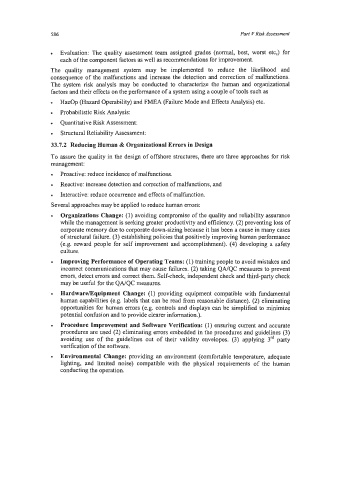Page 610 - Marine Structural Design
P. 610
586 Parr V Risk Assessment
Evaluation: The quality assessment team assigned grades (normal, best, worst etc,) for
each of the component factors as well as recommendations for improvement.
The quality management system may be implemented to reduce the likelihood and
consequence of the malfunctions and increase the detection and correction of malfunctions.
The system risk analysis may be conducted to characterize the human and organizational
factors and their effects on the performance of a system using a couple of tools such as
HazOp (Hazard Operability) and FMEA (Failure Mode and Effects Analysis) etc.
Probabilistic Risk Analysis:
Quantitative Risk Assessment:
Structural Reliability Assessment:
33.7.2 Reducing Human & Organizational Errors in Design
To assure the quality in the design of offshore structures, there are three approaches for risk
management:
Proactive: reduce incidence of malfunctions.
Reactive: increase detection and correction of malfunctions, and
Interactive: reduce occurrence and effects of malfunction.
Several approaches may be applied to reduce human errors:
Organizations Change: (1) avoiding compromise of the quality and reliability assurance
while the management is seeking greater productivity and efficiency. (2) preventing loss of
corporate memory due to corporate down-sizing because it has been a cause in many cases
of structural failure. (3) establishing policies that positively improving human performance
(e.g. reward people for self improvement and accomplishment). (4) developing a safety
culture.
Improving Performance of Operating Teams: (1) training people to avoid mistakes and
incorrect communications that may cause failures. (2) taking QNQC measures to prevent
errors, detect errors and correct them. Self-check, independent check and third-party check
may be useful for the QAIQC measures.
HardwareDCquipment Change: (1) providing equipment compatible with fundamental
human capabilities (e.g. labels that can be read from reasonable distance). (2) eliminating
opportunities for human errors (e.g. controls and displays can be simplified to minimize
potential confusion and to provide clearer information.).
Procedure Improvement and Software Verification: (1) ensuring current and accurate
procedures are used (2) eliminating errors embedded in the procedures and guidelines (3)
avoiding use of the guidelines out of their validity envelopes. (3) applying 3d party
verification of the software.
Environmental Change: providing an environment (comfortable temperature, adequate
lighting, and limited noise) compatible with the physical requirements of the human
conducting the operation.

